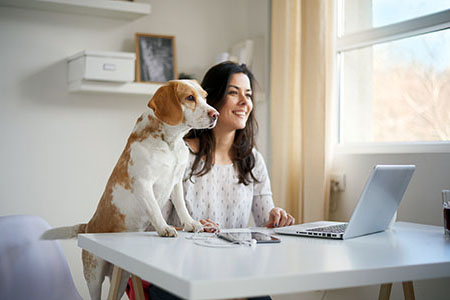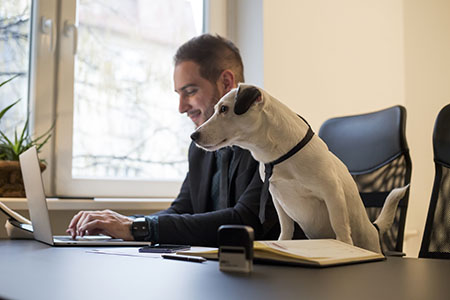 |
| |||
 Let the office go to the dogs Working from home became, for many people, WFH with pets. As we slowly return to the workplace, employers need to make more room for our four-legged coworkers. 26-Oct-21 – Many businesses are now struggling to develop the appropriate internal rules and material changes they need to promulgate as their employees slowly – and often grudgingly – return to their workplaces, even if that’s just part time. Seems that everyone has their own ideas about what it’s going to take to handle what is likely to be a yearlong transition back to the new normal. And this, of course, assumes that there are no new “helpful” or even coherent guidelines from state, local, or federal governments. We’re pretty much going to be on our own here, although anyone not moving toward mandatory vaxxing for onsite employees is definitely headed in the wrong direction. Striking the right balance between working from home and being at the workplace won’t be easy. Managers are searching for the right tradeoffs between the many comforts, cost savings, and other benefits we’ve come to value in WFH scenarios – including certain clear productivity boosts – and the traditional rationale we’ve always relied upon to justify our daily, expensive, and time-consuming pilgrimages to the “office,” where we allegedly gather with other team members to commingle, collaborate, and converse around the water cooler. How much of these additive and culturally beneficial community activities and serendipitous interactions allegedly leading to great new innovative approaches actually happened in millions of stratified, siloed, and carefully separated companies is a question for another day. But in any event the great RTO (return to office) debate is hard upon us and there’s really no way to avoid it. I realize that in some ways this is a much different and more complicated issue and concern for our millions of “essential” workers in hotels, hospitals, factories, and retail stores, even though those businesses have always used variable shifts and flexible hours to manage their workforces. So, in some respects, it’s less of a new and different set of plans and calculations for them, but it’s going to be much more complicated this time around because some of the proposed changes and solutions are never going to be “one size fits all.”
This is not simply a case of the decisions being made by senior white-collar workers. It’s really embedded and inherent in the nature of the work that various groups of employees perform. But that doesn’t make it go down any easier with the folks in the clinics or on the factory floor. And even for the men and women who grew up in the typical 9-to-5, five-days-a-week-and-most-Saturday-mornings office world, these are going to be somewhat uncharted and perilous waters. You don’t want to break down and bribe or beg your team members to come back but you are definitely going to need some concrete plans to ease and incent their return. We’re seeing new in-office initiatives around childcare, concierge services, and subsidized commuting, but these are fairly complex and costly efforts. Interestingly enough, one of the relatively easy solutions – adopted long ago by companies like Google and Amazon – is to make your offices pet-friendly and let your employees bring their pets to work. Thousands of pets ready to RTO Most employers haven’t the slightest idea of how many of their workers now have pets at home. Just to give you some idea, consider that almost 13 million homes got a new pet after March 2020, according to the American Pet Products Association. In 2020 alone, there were almost 275,000 pet adoptions from animal rescue groups. Remarkably, and much to the relief of these nonprofit groups, the feared rush to return adopted pets once the world began to get back to work hasn’t materialized. And we know why. While there’s no question that all of the additional time at home due to the pandemic has been good for many families and put new emphasis on the importance of balancing our home and work obligations, it’s been absolutely great for pets and their owners. In fact, we may be closer than ever to our families, but we’re really, really close to our animals.
Kids may be nice and even loving, but dogs are loyal and grateful and nothing’s better than that. A dog is the only thing on Earth that loves you more than he loves himself. I’m not sure what to say about cats. They seem more uppity and entitled, but then to each his or her own. The bottom line and the moral of the story is simple. If you want to get ahead of the game and anticipate the forthcoming demands as you try to pry your people away from their pandemic pets, now’s the time to start thinking about setting aside some space and make a plan to accommodate a whole new four-legged population to the office. Now would also be the time to talk to your landlord because, unlike the big tech firms, which generally own their own spaces, you’re going to need the building’s permission and assistance in making the appropriate changes – including who gets to ride in the elevators and when. Finally, just when you thought you could get rid of some of the excess air cleaning and filtering machines littering your space, remember that dogs don’t need clothes because they come with fur coats. And plenty of your employees will have allergy issues with all the pet fur and dander floating around. Doggone it, this is going to be fun.
Photos by Milan Ilic, Chriss Mex, and Monika Wisniewska. By Howard Tullman | Loop North News | h@g2t3v.com |




